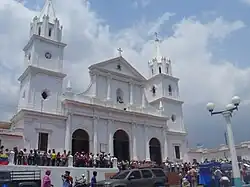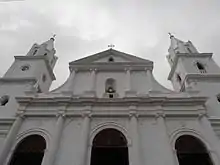Basilica of Our Lady of Consolation, Táriba
The Basilica of Our Lady of Consolation of Tariba[1]Spanish: Basílica de Nuestra Señora de la Consolación) is a Roman Catholic Marian shrine and basilica located in the [2]Táchira state of Venezuela.[3]
| Basilica of Our Lady of Consolation | |
|---|---|
Basílica de Nuestra Señora de la Consolación | |
 | |
| 7°49′04″N 72°13′36″W | |
| Location | Plaza Bolívar 5001, Táriba |
| Country | |
| Denomination | Roman Catholic Church |
| Administration | |
| Diocese | Roman Catholic Diocese of San Cristóbal de Venezuela |
The shrine was started by the Order of Saint Augustine who needed a church of sufficient hierarchy and dimensions sufficient for a growing parish as well as pilgrims. The Catholic priest, Father Francisco Martínez de Espinoza, curate and vicar of the Villa of San Cristóbal, began the construction of the first temple dedicated to the Virgin of Táriba on 19 August 1690, which would later also be replaced due to repeated earthquakes and expansion.
Pope John XXIII raised the shrine to the status of Minor basilica via the Pontifical Decree Solacium ac Levationem on 20 October 1959. The basilica enshrines a venerated Marian image that was granted a Pontifical decree of coronation titled Alacres Dei on 9 November 1959. The rite of coronation was executed on 12 March 1967 by the former Archbishop of Caracas, Cardinal José Humberto Quintero Parra. The present church is dedicated to Our Lady of Consolation, the patroness of the state of Táchira.
The reconstruction of the building was made by the efforts of Monsignor Miguel Ignacio Briceño Picón and Monsignor Alejandro Fernández Feo during the period of 1904 and 1913. It was remodeled under the administration of Monsignor Alejandro Figueroa Medina for the approaching date of the canonical coronation of the virgin. The basilica was critically rebuilt in the 1960s due to the contributions of Martín Marciales Moncada.

References
- Basilica of Our Lady of Consolation in Táriba
- Duque, Ana Hilda; Paredes, Niria Suárez de (2005-01-01). Congreso Internacional Centenario Archivo Arquidiocesano de Mérida, 1905-2005: el patrimonio de la Iglesia en Venezuela 6 al 12 de noviembre de 2005, Mérida-Venezuela : resúmenes (in Spanish). Centro Editorial Litorama.
- Duque, Ana Hilda (2008-01-01). Cuentas de una devoción: manuscrito de la Cofradía Nuestra Señora de la Consolación de Táriba : 1788-1803 (in Spanish). Universidad de los Andes. ISBN 9789806674202.